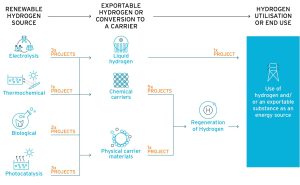Success for ARENA hydrogen R&D funding
An ARENA Knowledge Sharing report reveals 16 hydrogen research and development projects have blossomed into several world leading start-ups, multiple patent applications, and unexpected advances.

ARENA is all about accelerating Australia’s transition to renewable energy. We support projects at various stages of development and installation, help fund reports and share the knowledge we gain along the way.
Large-scale renewable hydrogen offers a promising solution to many challenges, but it is still a relatively new field of research.
That’s why ARENA has, over the past decade supported hydrogen research and development (R&D), including a $25 million funding round launched in April 2023.
Hydrogen is already big business. From 2020 to 2021, the World Bank valued the hydrogen production market at $130 billion. But industry produces the vast majority of hydrogen from fossil fuels.
In fact, the International Renewable Energy Agency estimated that in 2021, electrolysis of water produced only 4 per cent of global hydrogen output. Green hydrogen, produced with renewable energy added up to only 1 per cent, or around 1Mt.
Australia, with its bountiful solar and wind resources, is well placed to boost the world’s supply of renewable hydrogen. That could open big export markets and feed into new, local industries.
Australian innovation
In December 2017, ARENA launched a R&D funding round to help accelerate the development of a potential renewable energy export supply chain based on hydrogen.
Subsequently, 16 separate research projects received a total of $22.1 million.

The projects each focused on one of three stages in the supply chain:
- renewable hydrogen sources;
- methods for either exporting hydrogen, or converting it into an exportable carrier;
- end use of hydrogen.
The newly released Summary of ARENA-Funded Hydrogen R&D Projects details each project’s scope, its lead organisation and project partners, and outcomes and next steps.
How do you measure R&D success?
The most promising commercialisation outcome of this funding round are new new start-up companies.
Research conducted in this funding round led directly to two commercial start-ups.
Jupiter Ionics, from a Monash University project on Ammonia from Renewables, has secured $5 million funding. Its technology involves a novel method of producing ammonia directly, to avoid the energy-hungry industrial process.
Meanwhile, Hydgene Renewables has spun out from Macquarie University’s project on biological hydrogen production. This fascinating project has developed a strain of bacteria that eats sugars and belches green hydrogen.
A third start-up, Hysata, span out from an unexpected outcome. In its research partnership with Monash University, the University of Wollongong developed a new class of highly efficient electrochemical cell, known as a capillary-fed cell. Hysata was born and has since attracted over $40 million in investment.
ARENA also recently announced funding for Hysata to develop and pilot a 200 kW stack as part of the HyGATE initiative along with German partners.
But that’s not all. There are 12 patent applications in the pipeline plus another two already successful.
Since its 2017 launch, the funding round has produced at least 62 academic papers either published or submitted for publication. And 73 presentations have been delivered at conferences around the world.
If ARENA’s 2017 Hydrogen R&D funding round was a pebble thrown into a pond, the ripples continue to spread.
LIKE THIS STORY? SIGN UP TO OUR NEWSLETTER

ARENA